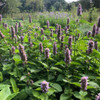
Agastache foeniculum - ANISE HYSSOP
Modest native perennial, easy to grow plant and true pollinator magnet. Finally we offer the true native one, because many plants and seeds on the market are Korean Mint - Agastache rugosum.
Upright clumps, spikes with small lavender-purple flowers, long flowering season can be supported by cutting it back (or deadheading). The original plant doesn't have to be super long-lived, but it will reliably self-seed.
Usually around 3'-4' tall x 2' wide, flowers from June to early September, hardy in zones 4 to 8.
It is native to parts of the upper Midwest and Great Plains (Wisconsin to Ontario west to British Columbia and south to Colorado). Naturally occurs in prairies, dry upland forested areas, plains and fields.
For full or partial sun, and medium moist to dry conditions. Adaptable to many soil types, preferably with some drainage (loam, clay-loam, or gritty or rocky soil), it will be shorter lived in pure clay. Drought tolerant.
Deer and rabbit usually avoid this plant. Parent of many garden cultivars.
It lookes well with daisy type flower of Echinacea, Coreopsis, Heliopsis, Rudbeckia, smaller Silphium or shorter cultivars of Helianthus, or with Asclepias or grasses.
Can be used in flower borders, wildflower gardens, herb gardens, butterfly or pollinator gardens, meadows or cottage gardens.
Nice cut flower or can be used for dried arrangements, minty leaves or flowers are suitable for potpourri or herb teas.
Pot Size : square 3.5" x 5" deep perennial pot
Picture copyright : US Perennials

Agastache foeniculum - ANISE HYSSOP
Modest native perennial, easy to grow plant and true pollinator magnet. Finally we offer the true native one, because many plants and seeds on the market are Korean Mint - Agastache rugosum.
Upright clumps, spikes with small lavender-purple flowers, long flowering season can be supported by cutting it back (or deadheading). The original plant doesn't have to be super long-lived, but it will reliably self-seed.
Usually around 3'-4' tall x 2' wide, flowers from June to early September, hardy in zones 4 to 8.
It is native to parts of the upper Midwest and Great Plains (Wisconsin to Ontario west to British Columbia and south to Colorado). Naturally occurs in prairies, dry upland forested areas, plains and fields.
For full or partial sun, and medium moist to dry conditions. Adaptable to many soil types, preferably with some drainage (loam, clay-loam, or gritty or rocky soil), it will be shorter lived in pure clay. Drought tolerant.
Deer and rabbit usually avoid this plant. Parent of many garden cultivars.
It lookes well with daisy type flower of Echinacea, Coreopsis, Heliopsis, Rudbeckia, smaller Silphium or shorter cultivars of Helianthus, or with Asclepias or grasses.
Can be used in flower borders, wildflower gardens, herb gardens, butterfly or pollinator gardens, meadows or cottage gardens.
Nice cut flower or can be used for dried arrangements, minty leaves or flowers are suitable for potpourri or herb teas.
Pot Size : square 3.5" x 5" deep perennial pot
Picture copyright : US Perennials









